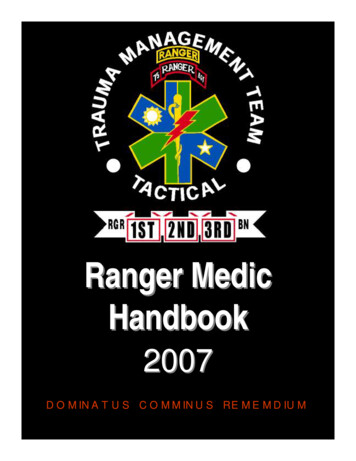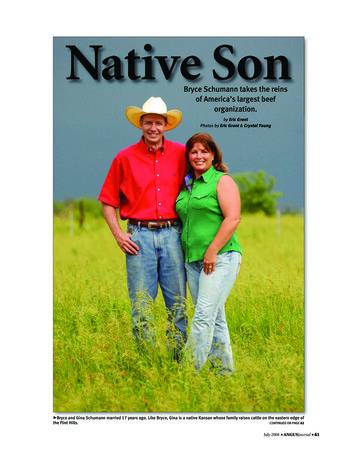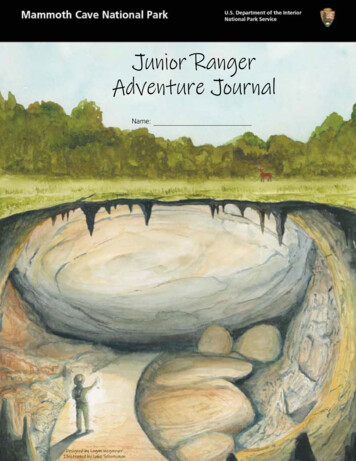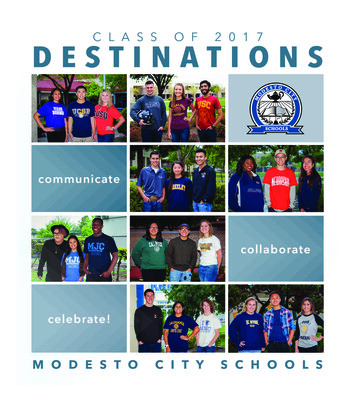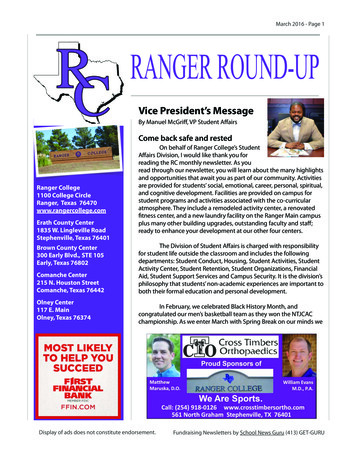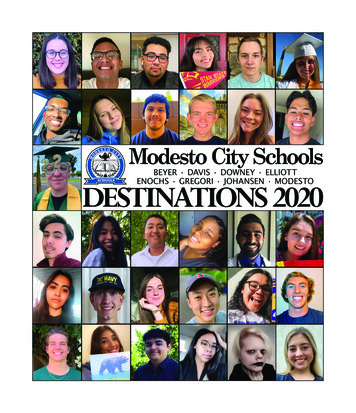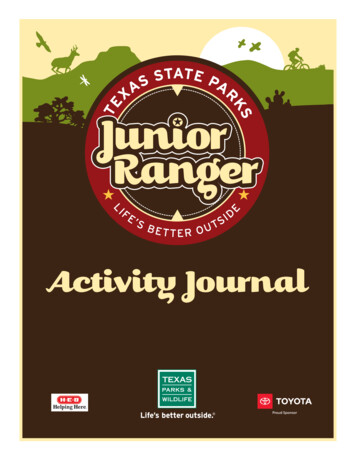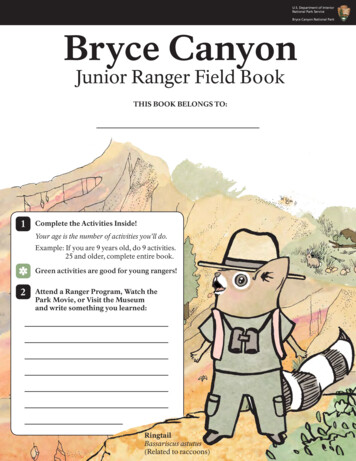
Transcription
U.S. Department of InteriorNational Park ServiceBryce Canyon National ParkBryce CanyonJunior Ranger Field BookTHIS BOOK BELONGS TO:1Complete the Activities Inside!Your age is the number of activities you’ll do.Example: If you are 9 years old, do 9 activities.25 and older, complete entire book.Green activities are good for young rangers!2Attend a Ranger Program, Watch thePark Movie, or Visit the Museumand write something you learned:RingtailBassariscus astutus(Related to raccoons)
Planning Your Day at Bryce CanyonUsing Your MapA Jr. Ranger knows how to read a map and knows where they’ve been in the park. Use the park mapbelow to circle every place you go during your visit. Below, write your favorite place that you visited.My favorite placeGuideldPolesngCaWWLayerrampraa ssstlehiFlafying GllassesngmerateCoWSuTrh B agasExtSunPFnihatcHikivesloe!reMagLiHBinCellFirsg BuddyinatkacensHikularsonePhrescas2Balmk MaparidGet Ready BingoocPShoesingtAA Jr. Ranger is prepared!Cross of all the items that youhave with you today.Can you get fve in a row?pFiekacGHikSnJr. Rangers know the park’s animals, and help protect them.lightsh
Your Junior Ranger Field Bookis all you need for this activity.Visit the Visitor Center or talk to aranger to help with this activity.Get outside and explore the parkto complete this activity.What’s Happening Today?Knowing what’s happening outside is an important part of planning a day at Bryce Canyon!What is the weather like today?High TemperatureF or CWhat time is sunset today?P.M.Low TemperatureF or CWhat time is sunrise tomorrow?A.M.I Hiked the Hoodoos! Complete this activity and receive a special reward!Hike a minimum of 3 miles / 4.8 km and fnd the benchmarks. Take a photo or a pencil rubbing(back page) of the benchmarks you fnd. If you are completing the entire book, this activity is optional.Mossy Cave (0.8 mi / 1.3 km)Tower Bridge (3.0 mi / 4.8 km)Bristlecone Loop (1.0 mi / 1.6 km)Rim Trail (2.5 mi / 4.0 km)Navajo Loop (1.3 mi / 2.2 km)Sheep Creek (4.0 mi / 6.4 km)Queen’s Garden (1.8 mi / 2.9 km)Peekaboo Loop (4.9 mi / 7.8 km)Peekaboo Loop (5.5 mi / 8.8 km)from Sunset Pointfrom Bryce Point3
Being in Bryce Canyon1I Spy!Warm up your observation skills by fnding these fve itemsin your book. Write the page number where you fnd them.Page #1Sensing Your ParkHow does it feel to be here?Go anywhere in the park and recordyour experience below.Location:I hear:I see:I smell:I imagine:I wonder:I wish:4
Your Junior Ranger Field Bookis all you need for this activity.Get outside and explore the parkto complete this activity.The Visitor Center Museummight help you with this activity.Prairie Dog Word TunnelsPrairie dogs have a very complex language that they use to protect themselves and their colony.Use your own word skills and solve the clues to connect all three burrow entrances!Across CluesDown Clues1. This person helps protect the park and keep prairie dogs safe8.2. These venomous reptiles with noisy names are predators of11. This room is where you’ll fnd the youngest prairie dogsThis is the name of the park’s summer rainy season12. This room helps keep the rest of the burrow cleanprairie dogs; watch your step in the summertime!13. This group of mammals, which includes squirrels, mice,3. This room is where prairie dogs can hear the world aboveand prairie dogs has front teeth that never stop growing4. This sleepy time usually lasts from November to March5. This scientifc feld of study includes prairie dogs and all other14. This plant has rough leaves and red bark; in Spanish itsname means “tiny apple”animals in the park (except humans)15. This large bird with an expensive sounding name is a6. This is the fastest land animal in North America, often foundcommon predator of prairie dogsgrazing near prairie dog habitat7. The sego lily and evening primrose are examples of this16. Like real dogs, what we call the sound prairie dogs make8. Male and female prairie dogs do this every spring to make17. Number of adult males in a prairie dog clan18. Cars that are prepared to do this can save prairie dog livesmore of 9-Across19. This hoofed animal with long ears grazes near prairie dogs9. What we call young prairie dogs199148155117113184261217163The Utah Prairie Dog is an endangered species. They were onceexpected to go extinct by the year 2000, but are now thrivingthanks to federal protections in places like Bryce Canyon.5
Geology of Bryce CanyonLifecycle of a HoodooPlace the hoodoo stages in the correct order (1 to 4) and answer the questions on the next page!Tip: Start by fnding the four stages in the background illustration.WindowRounded HillWall or FinHoodooCreate a HoodooFind a favorite hoodoo and draw it below.Don’t forget to give it a name!6My hoodoo’s name
Attending a Ranger-led GeologyTalk might help with this activity.Your Junior Ranger Field Bookis all you need for this activity.The Visitor Center Museummight help you complete this activity.How would you describe a hoodoo to someone that had never seen one?3 forces that weather & erode our rocks: 1.2.3.Know Your LayersDraw lines to match the rock layer to its description and fll in all of the missing words!The hoodoos of Bryce Canyon are part of the formation, which is around50 million years old. This formation is also called the Pink Clifs, which is the verystep of the “Grand Staircase”. Bryce Canyon contains the mosthoodoos on Earth, but it’s not really a canyon because it has no .Dolomitic LimestoneWhite LimestoneRed LimestoneMudstoneThis layer is than others, so it erodes awaymore quickly. Look for the skinniest parts of a hoodoo.Magnesium makes this layer than others.It forms a “hat” layer that erodes more slowly than others.These layers are formed of nearly pure calcium carbonatethat settled at the bottom of a fresh-water .These layers have calcium carbonate and other sedimentsrich in the element , which gives a red color.7
Plants of Bryce CanyonPlant Safarietchesof 3SmellbeCluGrowsening Asp2. Quakit!I foundn:Locatiolye: Needles1owgrunbininch per centuryslike fox tails quickly in burnrowedg;arieseasin colonebkilon hair-lates of its barkPinosader t!noi1. P foundI:iontacLon:ueClTinyseedswrasseGciRianInd und it!I fo n:athatioLoc d Use PreShahe pnteeSomeothat likes to growinfuranchessrashgcnunll sA smallbuFind at least two of these seven plants in the park. Be sure to fll out the entire tag!:Ne edve,ueCl:ueClLokarokbfor th r whiteeilooknene PistlecoirB.3it!I foundion:Locatles in buncheffosPlant Facts Choose from the plants above to complete these plant descriptions!The oldestSmall red berries givein the park was found to be around 1,600 years old.its name, which means “tiny apple” in Spanish.grows in groups, and may have arrived here over 10,000 years ago.Along with the pinyon pine,The spaces between the bark ofAlong with the spruce tree,Edible seeds have madeLeaves of8defnes the park’s lowest elevation zone zone.smell like vanilla or butterscotch.defnes the park’s highest elevation zone zone.an important grain for native peoples.change from summer green to winter purple.
andcdlerpahss aresoft (notwb-likeconesMediuacedar(er: Look for blue bmlooryome blue bers becriese7. Oregon GrapI found it!Location:),Ne:ClueeClueFirhite t!W.6nd iI foun:atioLocd, shady foreswdetsorces calledlownsiwtheir rekarbdurl upwardGroLook forernip it!uJ5.undI fon:tioacLommetim, soeetrnuCle:-nitanza !a4. M und itI fon:atiocoLesnub, do ’t like shashrdeesizYell omThe Visitor Center Museummight help you complete this activity.o t)snit’AmediuGet outside and explore the parkto complete this activity.owdkClue: LooName:WhereI foundit:Mystery PlantDraw a plant you fnd, and fll out the tag.If you can’t fnd its name later, make one up!9
Animals of Bryce CanyonWho left it?Circle the names of animals you see.Never feed a wildanimal, and alwayskeep your distance!Signs of animals are everywhere.Write or match the animals(at left) that left these signs.BobcatLeaves no clawmarks in trackRufousHummingbirdMigrates fromMexico3.75”Keep your eyes open!2”RingtailFive toes onboth feetPygmy NuthatchOur smallest nuthatchWho left it?Steller’s JayMay mimic screech of hawks1”Common RavenDoes not digest furor bones1”Downy WoodpeckerAbout the size of a robinWho left it?2”White-breasted NuthatchDescends trees head-frstCoyoteClaw marksin tracks2”Mule DeerLeaves pellet scatBrown CreeperAscends tree head-frstWho left it?Desert CottontailRear track is larger.25”Golden-mantledGround SquirrelWhite eye-ring,shreds pine cones.25”10Utah Prairie DogLives in underground coloniesWho left it?
Get outside and explore the parkto complete this activity.Your Junior Ranger Field Bookis all you need for this activity.Track yourself!1”Your hand can be a great way to measure tracks.Trace your hand below, then choose an animal track (at left)and draw it on top of your hand to show how their sizes compare.71”6Who left it?3”52.5”4Who left it?2.25”32”2Who left it?1.754”.50.251”Example: A Bobcat track would be thislarge on a hand with a 2 inch palm.Who left it?11
Humans of Bryce CanyonWhat Parks Mean To Us (Interview)National parks exist all around the world, and they mean diferent things to diferent people.Ask someone visiting the park today these questions, and write their answers below.Which was the frst national park you ever visited? When did you visit?What do you remember about that experience? If Bryce Canyon is your frst, why did you come?What do national parks mean to you?Of all the national parks you’ve visited, which was the most special to you? Why?12
Your Junior Ranger Field Bookis all you need for these activities.A Ranger-led Rim Walk mightgive you ideas for this activity.Get outside and explore the parkto complete these activities.Naming the World Around YouMany names in and around the park come from the language of the Southern Paiute people, who stilllive in this area today. Their language describes places by things that happened there, who lives there,or what it looks like. Think about what makes this place unique as you complete this activity.PAUNSAUGUNT Plateau: Place of the BeaverPARIA: Muddy WaterYOVIMPA: Ponderosa Pine Tree WaterPANGUITCH: Fish WaterUNKA TUMPI WUN-NUX TUNGWATSINIXOOPAKICHU ANAX (BRYCE CANYON):Red Rock Standing Like a Man in a HoleWhat is most special about this place to you?If it had no name, what would you call this place?Being a Good StewardSettlers from The Church of Jesus Christ of Latter Day Saints arrived here in the 1860s. Bryce Canyon’sname comes from one of these settlers, named Ebenezer Bryce. This faith teaches the importance of caringfor all of the life that exists on this planet. You can help take care of this land too by picking up at least 10pieces of litter you fnd during your visit. Cross of a trash can for every piece you fnd!13
Night Skies of Bryce CanyonThe North StarAt this latitude, the stars that circle the North Star (Polaris) are always visible, so you can see themat any time of year. Complete this page to learn three ways you can fnd the North Star tonight.ShedirCepheusRuchbahCassiopeia looks like an M, E, W, or 3depending on its rotation. Think of it astwo triangles, with Shedir and Ruchbah attheir tops. Draw two lines, one from each star,through the middle of their triangle. The NorthStar will be near where these lines meet.DragonGirafeThe Big Dipper is one part ofa larger constellation called theGreat Bear. The stars Dubheand Merak are known as the“Pointer Stars”, because theypoint to the North Star.Draw a line through these twostars to fnd the North Star.KochabThe Little Dipper is dimmer thanthe Big Dipper, but is just asimportant because it contains theNorth Star at the end of its handle.Circle the North Star and write“Polaris” next to it.ThubanAlcor MizarDubheMerakPaiute stories describe the sky as a world above us, withplants, animals, and mountains pointing back at us. Na-gah, themountain sheep, climbed the tallest mountain in that world,and became stuck. Food began to run low, so as an act of mercy,na-gah was turned into a star. Other mountain sheep trying toclimb up from below became the Big and Little Dippers.This is why the North Star never moves,and the other constellations circle it.14
Your Junior Ranger Field Bookis all you need for these activities.Visit the Visitor Center or talk to aranger to help with these activities.The Visitor Center Museummight help you solve these activities.Just a PhaseIt takes about 28 days for the moon to orbit Earth and go through all of its phases. Some phases are betterfor stargazing than others. Shade in the missing phases, and answer the questions below!Getting “bigger” (“Waxing”) Bright area looks like the letter DNew MoonRisesat sunriseWaxing CrescentRises a few hoursafter sunriseFirst QuarterRises aroundnoonGetting “smaller” (“Waning”) Bright area looks like the letter CWaxing GibbousRisesmid-afternoonFull MoonRisesat sunsetWaning GibbousRises a few hoursafter sunsetLast QuarterRises aroundmidnightWaning CrescentRises a few hoursbefore sunriseWhich phase is the moon in tonight?Will tonight be a good night forstargazing? Why or why not?Losing the NightFor a few days a month the moon can make it difcult to see the stars, but in most placesartifcial light now makes it difcult to see stars every night of the year. One of the best thingsyou can do to help bring back the stars is to “shield” the lights around your home.Draw a shield on the left lightbulb and drawlines to show how a shield directs the light.Unshielded Light creates light pollution byallowing light to shine in all directions, includingthe sky, where dims the stars.Light pollution not only makes it difcult to seethe stars, but confuses animals, plants, and ourbodies, all of which are carefully adapted to thebrightness of the day and the darkness of the night.Red light can help preserve night vision,so it’s the best light for stargazing.15
Protecting the Future of Bryce CanyonWhat Comes After a Fire?Wildfre is nature’s way of keeping house. When no fre occurs, forests become dense and overcrowded,making them less healthy and vulnerable to larger, more destructive wildfres. After a fre, grasses takeadvantage of lots of sunlight on the forest foor. Then shrubs arrive, providing berries and more for animalsto eat. Finally, tall trees return to the area, providing more food and shelter. The order that plants returnafter fre is called “succession”. Use the plant clues on Page 8 and 9 to put these plants in the correct order(1 to 4) of succession.A Changing ClimateRapid increases in global temperature and CO2 are one of thegreatest challenges afecting your national parks. Complete thisactivity to imagine how a changing climate might afect Bryce Canyon.A Freeze/Thaw cycle is whenrain or melted snow freezes atnight and then melts duringthe afternoon. This currentlyhappens about half the nightsof the year here.Frequent Freeze/Thaw Cyclesshape rocks bit by bit, andcreate tall, narrow hoodooslike Thor’s Hammer.16Higher global temperatureswill mean fewer Freeze/Thaw cycles, and possiblymore rain here than snowand ice. Hoodoos formed inthis environment could lookvery diferent than what yousee today. Write or drawhow more rain-shapedhoodoos might look.
A walk on the Bristlecone Loopmight give you ideas for this activity.Your Junior Ranger Field Bookis all you need for this activity.Deciding the Future of Your ParksClimate Change? Overcrowding? Cell Phones? Lack of interest? Try and think of one challenge thenational parks will face in your lifetime. Below, write something you think that you and theNational Park Service can do to better face that challenge.A challenge facing the national parks is.Something the National Park Service can do to help is to.Something that I can do to help is to.17
The Way of the Junior RangerThe Maze of DecisionsComplete the maze by making the best decisions at each situation.For Situation #11, draw or write a good decision you made whilevisiting a national park, and then find the correct path to the end.The way ofthe juniorranger1. Got to the trail3. pick itSTARTup or leave ithead, by private helicopter, by gaspowered car, or by shuttle busthe way of the juniorranger is one markedby manty importantdecisions. Choosewisely-your choices haveimpacts beyond yourself.5. A golden-mantled ground squirrel!oh hi,Cont. tosixfeed him4. what's2. Pfew! I'mthirsty! take a drinkfrom yourthatreusable wateryour extra granola baror respect his spacein the woodsgo checkit out or staybottle, take a drinkfrom your single useplastic water bottle, orwhoops! youforgot to bringwater ask a friendon the trail
Your Junior Ranger Field Bookis all you need for this activity.9. Brr! Builda fire onthe Rim6. Call a friend to tell themeverything as you hike, turn onyour boam box & howl like a wolf,8.Wow!leaveGreatsFinds!trail, put onora layer,build a fire onthe queen'sgarden trailem' or keep em'or share your enthusiasmquietly within your group10. People are using telescopesahead! turn your headlampto the red light setting, sneakup on them in the dark and7. Someone iscarving into theaspen! add yourname, build a nearbycairn to alert themake scary animal sounds,or wave your flashlight atthem to say hello!next hiker,or ask them tostop or tell a ranger11.hint:12. You made it!Write themakethe rightchoice"park to tell us about yourexperience! Bryce CanyonNational Park PO Box 640201Bryce, UT 84764
I Hiked the Hoodoos (page 3)Use this space to make pencil rubbings of benchmarks!JR. RANGER PLEDGEAs a Bryce Canyon Junior Ranger.I promise to do all I canto help protectmy national parks.I will collect litterwhen I’m out exploringand show respect for natureby not disturbing anything wild.JR. RANGER’S NAMEPARK RANGER’S NAMEPARK STAMPArtwork by Kadi Fransonwww.kadifranson.com
Junior Ranger Field Book THIS BOOK BELONGS TO: 1 . 2 . Complete the Activities Inside! Your age is the number of activities you'll do. Example: If you are 9 years old, do 9 activities. 25 and older, complete entire book. Green activities are good for young rangers! Attend a Ranger Program, Watch the Park Movie, or Visit the Museum

